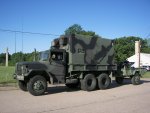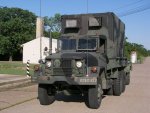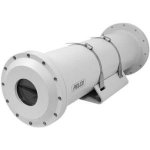Lot of fun this is. I did not expect so much interest and good suggestions, and also fellow RADAR operators.
I like the door openers. They are fun and will also set off people's radar detectors, making it even funner. In days past I sent video across the shop with one and used a hacked (disable scanning, manual tune) radar detector to receive it. was not pretty but it worked. I got rid of most of my microwave stuff except a couple pieces of test gear a long time ago.
I've had another radar before, an old Pathfinder with a 4FT diameter radome. Big all-analog beast with no CPU, just logic chips and transistors and a huge separate power supply. It was substantially more powerful than the 4KW and lower models seen today. It had to be, because the receiver technology wasnot as good. That thing would light up flourescent lamps.. I traded it to a skipper for a Tektronix digital scope in maybe 1985? a good trade then.
I should address licensing:
The radio station license for a ship's radio station would cover the RADAR (assuming this was applied for). If you have a RADAR on your ship as part of your ship radio station (radio gear excuding if I am not mistaken some small marine handy talkies etc), it is all supposed to be licensed for use. Many people do not bother and it is not enforced much.
On land there are many fixed users and a few mobile users. The mobile user is expected to self-coordinate and avoid interfering with land based RADAR installations. That is tedious, but the locations and frequencies of licensed land based RADARs are all available in the FCC database. So I am expected to survey and search my expected AO and not operate within range of another RADAR on the same or nearby frequency.
My operating license is land mobile radiolocation/weather RADAR. It cost $260. It took alot of digging to find this classification on the FCC web page. Once found, they gladly helped me over the phone to fill out the confusing online forms and took the money.
Note: GROL + RADAR is an incpomplete statement.
It is GROL + Ship RADAR. The endorsement is not required for land mobile radiolocation and conveys no special authority over any other operating license to service land based RADARS. It applies only to the requirement to service ship RADARS. This was also told to me as I discussed these matters with the FCC.
There is a
super cool factor. Those considering this, please be prepared to license it and make sure it is working properly because on land it is more likely to interfere with important fixed radars. Fixed radars have primary authority. The FCC probably does not have any boats to go looking for waterborne "violators" with. But they do have cars that do more than 55MPH, hehe.
If considering a RADAR, an enclosed radome is better in the wind. An open array, like a beam that rotates, could get punished by the wind of driving. Here is a link to Raymarine (was raytheon) where you can download complete tech manuals for "retired" units like mine. Schematics and all.
Raymarine Marine Electronics - Retired Radar Manuals
About the RADAR unit:
Radome section:
The radar "radome" is a Raytheon 10X model with a 1.5KW peak power and a range of 16 miles, average power is around 0.27 watts on the short ranges (0.08uS pulse width) and 1.6 watts on the 16 mile range at 0.5uS pulsewidth/750 Hz.
It uses 12-36VDC and with 12V it draws right at 3 amps.
It has a 6 degree horizintal beamwidth, mostly due to its small rotating array size inside the dome. This means that cows appear longer degree-wise than they really are - like 5 degree wide streaks instead of dots. The closest object that can be detected is about 35 meters distant. The array type is a flat printed circuit array, microstrip type with multiple patch radiators. This is much more compact than the slot-fed horn type antenna due to the phasing techniques of the stripline construction. So one could say it is a phased array, however, the phase and therefore beam pattern is fixed.
The receiver has a 60MHz center Intermediate Frequency and downconverts to this from the 9445Mhz transmit frequency using a klystron which takes an automatic frequency control signal from each pulse of the magnetron so that it self-tunes, just like the AFC on an FM tuner. The I.F. bandwidth is 10MHz or 3MHz, depending on range selected.
The signal to the display/controller is an analog video signal. The synchronization for the bearing line (dead ahead direction) is done by a Hall sensor and a magnet. The magnet is mounted on the antenna drive gear. The antenna turns at 24RPM. The microwave energy passes to and from the antenna through a rotating joint in the waveguide assembly. Much of the microwave "plumbing" section is built into the baseplate of the unit. The T/R switch, magnetron, and klystron are replaceable.
Back to the video signal, it is standard analog PPI-based video. If I wished, and decided to build up a sweep circuit for it, I could display it on any PPI display such as the 15" FAA one in the lab. But with such a small radar, it is not worth it to take up that much space and power for a huge display CRT in my truck. (Note "PPI" - plan position indicator- is the regular "traditional" kind of sweep-around radar display shown in the movies)
All of the above is in the scanner radome. It weighs 12 lbs.
Display head:
The display is also the controller. It is a model 40XX, for a 4KW radome unit, but will operate this 10X unit OK because of the way it commands pulsewidths and repetition rates, there are no issues. I went through the schematic diagrams of both units before buying this.
The video signal enters an A/D converter and is then sent to a dual port memory. From there it is addressed out into a raster scan pattern like a regular CRT based TV set. So the round scan patten gets converted to a TV-scan like screen. There are 8 levels of gray (green) which correspond to the relative intensity of the original video signal at any one given moment. I do not prefer digitization, but it's OK for this.
alignment and testing:
Before going cow-spotting, I have done some alignment on this unit. It was pretty close even after being a bit aged. It is old in years but I do not think it has many hours as it is very clean inside. usually some corrosion creeps up the mounting bolts and makes aluminum oxide inside the unit. Realignent of the I.F. and also narrowing it a little and increasing the gain as well. Also reduced the AFC loop time constant. (I always got to hack something..) I left the transmitter alone because it is doing about 1400W peak, and that is OK.
I had to fix a crack in the radome. I did it with a fiberglass cloth repair kit. For a first time try, it worked very well.
The only other mod I might do is to give some elevation to the rotating antenna array so that less energy hits the ground and more goes into the sky. The vertical beamwidth is 25 degrees. So 12.5 of that is hitting the ground.. and I'm getimg loads of ground clutter close in. If I elevate the array by maybe 8 degrees, I should be able to get rid of at least 3/4 of that or 6dB. A good experiment. I'll study it and maybe get a machine shop to help (mill).
wants:
I am currently looking for a working Raytheon/Raymarine 20x, 20xx, 40x, or 40xx radome because that's what the display is for and I'd like more range, out to some 36-48 miles. The object to to detect impending doom, er.. zombies, and weather. Part numbers would be:
M92539
M92549
M89950
The radomes are the less costly item it seems. The 40XX display was where the bucks were. - it was so odd how the guy I got it from decided to sell it to me. He is using a smaller form factor display (7" CRT) because this slightly larger, more capable one (10"CRT) did not LOOK RIGHT on his bridge. Come on he is running a 36 Ft "Whaler" model of boat that has to be 20-30 years old! I mean it's not an old tub or anything, a real nice solid boat allright, but I'd never trade function for interior decorating. He does have a nice job with it. Takes people out fishing.
The 40xx will also do the navigation stuff and has a sub-window for it. It can take NMEA and MARPA data as well and has a bearing indicator input. I can't use that since the M35 has so much metal..
The whole thing cost $425. $150 was for the radome, the rest for the display unit.
Gun ring:
There is no gun ring on the truck, just a hardtop. It might be interesting to have the radome rise up through a gun ring - but that would cramp the the passenger.







